
Jacopo Bellini was one of the founders of the Renaissance style of painting in Venice and northern Italy. His sons Gentile and Giovanni Bellini, and his son-in-law Andrea Mantegna, were also famous painters.
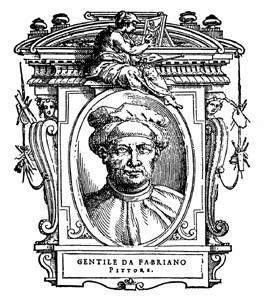
Gentile da Fabriano was an Italian painter known for his participation in the International Gothic painter style. He worked in various places in central Italy, mostly in Tuscany. His best-known works are his Adoration of the Magi from the Strozzi Altarpiece (1423), and the Flight into Egypt. Following a visit to Florence in the 1419, he came in contact with humanism, which influenced his work throughout the rest of his career. He became highly influential for other painters in Florence, especially because of his use of detail based on the observations he made of the natural world.

Fabriano is a town and comune of Ancona province in the Italian region of the Marche, at 325 metres (1,066 ft) above sea level. It lies in the Esino valley 44 kilometres (27 mi) upstream and southwest of Jesi; and 15 kilometres (9 mi) east-northeast of Fossato di Vico and 36 kilometres (22 mi) east of Gubbio. Its location on the main highway and rail line from Umbria to the Adriatic make it a mid-sized regional center in the Apennines. Fabriano is the headquarters of the giant appliance maker Indesit.

The Adoration of the Magi is a painting by the Italian painter Gentile da Fabriano. The work, housed in the Uffizi Gallery in Florence, Italy, is considered his finest work, and has been described as "the culminating work of International Gothic painting".
The decade of the 1420s in art involved some significant events.

The Valle Romita Polyptych is a painting by the Italian late Gothic painter Gentile da Fabriano, dating from c. 1410-1412 and now housed in the Pinacoteca di Brera in Milan. It was originally executed for the Franciscan hermitage of Valle Romita near Gentile's birthplace, Fabriano.

The Madonna of Humility is a tempera-on-panel painting by the Italian late medieval artist Gentile da Fabriano, dating from around 1420-1423 and housed in the Museo nazionale di San Matteo, Pisa.

The Adoration of the Christ Child is a tempera and gold on panel painting by the Italian late medieval artist Gentile da Fabriano, dating from around 1420–1421 and housed in the Getty Center of Los Angeles, United States.
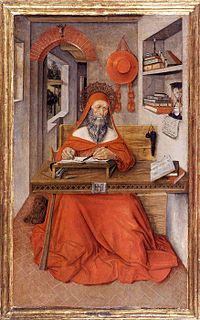
Antonio da Fabriano was an Italian painter, active in the Region of Marche.

Madonna and Child is a tempera on panel painting of the enthroned Madonna and Child by Gentile da Fabriano. At its base are small angel musicians. It is now in the Galleria Nazionale dell'Umbria in Perugia.

Saint Francis Receiving the Stigmata is an oil and tempera painting by Gentile da Fabriano, executed c. 1420, now in the Magnani-Rocca Foundation in the Province of Parma in Italy. It is the back of a processional banner - the front showing the Coronation of the Virgin is now in the Getty Center in Los Angeles.

Coronation of the Virgin is a tempera painting by the Italian artist Gentile da Fabriano, executed c. 1420, now in the Getty Museum. It originated as the front of the a processional banner - the reverse showed Saint Francis Receiving the Stigmata and is now in Parma.

Madonna and Child is a c. 1400-1405 tempera and gold leaf on panel painting by Gentile da Fabriano, now in the Pinacoteca Nazionale di Ferrara. It is signed at the base. Before being restored in 1980 it was thought to be by a follower of the artist due to thick repainting on the whole work.
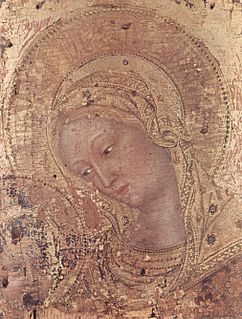
Madonna and Child is the only surviving fragment of a larger tempera and gold on panel painting by Gentile da Fabriano, executed c. 1423–1425. It is now in the Berenson collection at Villa I Tatti in Settignano. It is dated to the artist's Florentine period due to stylistic similarities with the Madonnas in his Quaratesi Polyptych and Yale Madonna
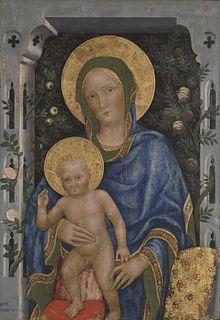
Madonna and Child is a tempera and gold on panel painting by Gentile da Fabriano, executed c. 1424, now in the Yale University Art Gallery in New Haven. It is signed on the left jamb "Gent / Fabriano". Previously traditionally dated to 1420–1423, the new accepted dating is based on similarities between the background architecture and the north door of the Florence Baptistery, completed by Lorenzo Ghiberti in 1424.
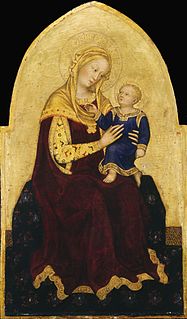
Madonna and Child is a tempera and gold on panel painting by Gentile da Fabriano, executed c. 1420–1423, now in the National Gallery of Art in Washington, D.C. The work is generally identified as one of the first the artist produced in Florence, where he had arrived in summer 1420, at roughly the point at which he was working on the Pala Strozzi. It may have been the central panel of a polyptych, the rest of which is now lost.

Madonna and Child with Two Saints or Madonna and Child in Glory between Saint Francis and Saint Clare is a c.1390-1395 tempera and gold on panel painting by Gentile da Fabriano, now in the Pinacoteca Malaspina in Pavia. It is one of the earliest surviving works attributed to the artist.

Madonna and Child with Two Saints and a Donor is a c.1395-1400 tempera and gold leaf on panel painting by Gentile da Fabriano, the earliest surviving major work by the artist. Probably painted for the church of Santa Caterina in Castelvecchio in Fabriano, near to which it is now in the Gemäldegalerie in Berlin.
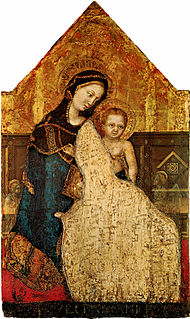
The Velletri Madonna is a tempera and gold on panel painting by Gentile da Fabriano, executed c. 1426-1427, the only surviving work from his stay in Rome. A Madonna of humility, it was in the church of Santi Cosma e Damiano until 1633 when Ludovico Ciotti di San Paolo, General of the Third Order Franciscans, donated it to the Church of Sant'Apollonia in Velletri. It is now in the Diocesan Museum in Velletri. A restoration in 1912 restored the top to its original triangular form.

The Intercession Altarpiece is a five-panel tempera and gold on panel painting by Gentile da Fabriano, produced during his stay in Florence from 1420 to 1423. Its original location is unknown, though it is now in the sacristy of Chiesa di San Niccolò Oltrarno in Florence. It is named after its central panel of Jesus and the Virgin Mary interceding to God the Father. The two outermost panels show Louis of Toulouse and Bernard of Clairvaux. The two inner side-panels show the Resurrection of Lazarus and a group of three saints.



















